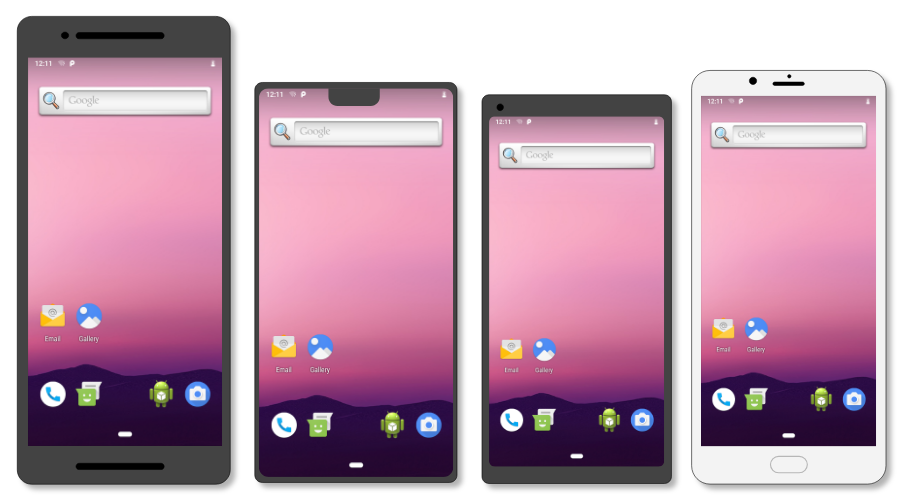تصویر سیستم عمومی ( GSI ) یک پیادهسازی خالص اندروید با کد پروژه منبع باز اندروید (AOSP) اصلاح نشده است که قابل اجرا بر روی انواع دستگاههای اندرویدی است.
توسعهدهندگان برنامه میتوانند جدیدترین GSIهای Android را نصب و اجرا کنند تا آزمایش برنامه را روی انواع دستگاههای Android موجود انجام دهند و از GSIهای مراحل مختلف انتشار سیستمعامل Android، از جمله پیشنمایش توسعهدهنده و ساختهای بتا استفاده کنند. افزودن GSI به فرآیندهای تأیید و آزمایش می تواند مزایای بیشتری برای شما به ارمغان آورد:
- پوشش آزمایشی گسترده تر در مجموعه بیشتری از دستگاه های واقعی
- زمان بیشتر برای رفع مشکلات سازگاری برنامه
- فرصت های بیشتری برای رفع مشکلات سازگاری در Android که توسط توسعه دهندگان برنامه گزارش شده است
پروژه GSI منبع باز است و با ارائه راه های بیشتر برای بهبود کیفیت برنامه و سیستم عامل قبل از هر انتشار اندروید به بهبود اکوسیستم اندروید کمک می کند.

GSIها دارای عملکردهای اصلی سیستم برای همه دستگاه هایی هستند که روی آنها نصب شده اند. به عبارت دیگر، یک GSI شامل سفارشی سازی های سازنده دستگاه نمی شود. به همین دلیل، ممکن است در شرایط زیر با تفاوت های رفتاری مواجه شوید:
- تعاملاتی که شامل UI می شوند
- جریان های کاری که ویژگی های سخت افزاری جدیدتری را درخواست می کنند
انطباق دستگاه را بررسی کنید
GSI ها فقط می توانند روی دستگاه هایی با ویژگی های زیر کار کنند:
- بوت لودر آنلاک است.
- کاملاً مطابق با Treble.
- با Android 9 (سطح API 28) یا بالاتر راه اندازی شد. دستگاه هایی که از نسخه قبلی به اندروید 9 ارتقا یافته اند ممکن است از GSI پشتیبانی کنند یا نه.
برای تعیین اینکه آیا دستگاه شما میتواند از GSI استفاده کند و کدام نسخه سیستم عامل GSI را باید نصب کنید، موارد زیر را انجام دهید:
با اجرای دستور زیر، پشتیبانی از Treble را بررسی کنید:
adb shell getprop ro.treble.enabled
اگر پاسخ
falseاست، دستگاه با GSI سازگار نیست و نباید ادامه دهید. اگر پاسخtrueاست، به مرحله بعد ادامه دهید.با اجرای دستور زیر، پشتیبانی از نسخه متقاطع را بررسی کنید:
adb shell cat /system/etc/ld.config.version_identifier.txt \ | grep -A 20 "\[vendor\]"
در خروجی، در بخش
[vendor]namespace.default.isolatedرا جستجو کنید.اگر مقدار آن مشخصه
trueباشد، دستگاه بهطور کامل از Vendor Native Development Kit (VNDK) پشتیبانی میکند و میتواند از هر نسخه سیستمعامل GSI (OS) که جدیدتر از نسخه سیستم عامل روی دستگاه است استفاده کند. در صورت امکان، از آخرین نسخه سیستم عامل GSI که در دسترس است استفاده کنید.اگر مقدار مشخصه
falseباشد، دستگاه کاملاً با VNDK سازگار نیست و دستگاه میتواند فقط از GSI برای همان نسخه سیستمعامل روی دستگاه استفاده کند. برای مثال، دستگاه Android 10 (API نسخه 29) که با VNDK سازگار نیست، میتواند فقط یک تصویر Android 10 GSI را بارگیری کند.نوع معماری CPU GSI باید با معماری CPU دستگاه مطابقت داشته باشد. برای پیدا کردن معماری CPU مناسب برای تصویر GSI، دستور زیر را اجرا کنید:
adb shell getprop ro.product.cpu.abi
از خروجی برای تعیین اینکه از کدام تصویر GSI هنگام فلش دستگاه خود استفاده کنید استفاده کنید. به عنوان مثال، در پیکسل 5، خروجی نشان میدهد که معماری CPU
arm64-v8aاست، بنابراین میتوانید از نوعarm64GSI استفاده کنید.
GSI ها را دانلود کنید
بسته به نیازهای توسعه شما، چند راه برای دریافت GSI وجود دارد:
- برای GSI های پیش نمایش Android و GSI های Android با GMS، تصاویر را از صفحه انتشار GSI دانلود کنید.
برای تصاویر GSI از پیش ساخته شده بدون برنامه های GMS، تصاویر را از سایت AOSP CI دانلود کنید:
برای ساختن GSI های اندروید بدون GMS، کد منبع را از AOSP دانلود کنید و GSI خود را بسازید.
یک GSI نصب کنید
نصب GSI وابسته به دستگاه است. برای اطلاع از ابزارها و مراحل دقیق به سازنده دستگاه خود مراجعه کنید. برای دستگاههای Google Pixel مانند Pixel 3 و جدیدتر، چندین راه برای نصب وجود دارد:
- چشمک زدن دستی تصاویر GSI: به الزامات برای چشمک زدن GSI ها مراجعه کنید
- استفاده از بهروزرسانی پویا سیستم (DSU) برای دستگاههایی که قبلاً Android 10 یا بالاتر را اجرا میکنند: به صفحه بهروزرسانیهای سیستم پویا مراجعه کنید.
بازخورد بدهید
GSI ها برای کمک به اعتبارسنجی برنامه های خود در Android در نظر گرفته شده اند. از بازخورد شما در مورد تصاویر، ابزارها و فرآیند استفاده از GSI در دستگاههایتان قدردانی میکنیم.
برای اطلاع از اشکالات یا درخواست های ویژگی، از مؤلفه اختصاصی ردیاب مسئله برای GSI ها استفاده کنید.

